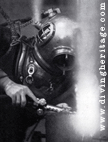SALVAGE:
In-Water INSPECTION:
- REASONS for Inspection
- Survey Inspection EQUIPMENT
- VESSEL In-Water Surveys
- Marine INFRASTRUCTURE Surveys
- MOORING Survey Inspection
- General Survey Inspections
- CORROSION Inspection
- Measuring Metal Thickness
- R.O.V. Inspection
In-Water CLEANING:
- WHY Cleaning? HOW to clean?
- HULL and RUDDER
- PROPELLER (cleaning/polishing)
- Marine INFRASTRUCTURE
- Sacrificial ANODES
- Water JETTING (high and low pressure)
In-Water REPAIRS, MAINTENANCE:
- Shipwork
- Cofferdam
- Marine INFRASTRUCTURE (overview)
- Single Point Mooring System (CALM & SALM)
- Wet WELDING & CUTTING
CIVIL WORKS & ENGINEERING:
- Dredging & Excavation off small BARGE
- Dredging, Jetting, Air-Lift, Dewatering by DIVERS
- Underwater DRILLING & BREAKING
- POST, PIPE, HOLLOW Section PILING with Portable hydraulic Hammer
- Maritime CONSTRUCTION
- Maritime DEMOLITION
- Marine OUTFALLS & Diffusers
- PIPELINES installation & maintenance
- Engineering
SEABED & EARTH ANCHORING:
- Cyclone Anchor Lines for rental

- MOORING Line: what's the (best) choice?
- HELICAL / SCREW Anchors information
- SCREW Anchors Mooring Systems
- PIPELING Anchoring
- Jetty & Walkway FOUNDATIONS screwing
- Expending Rock Anchors
- Grouted Rock Anchors
- Instant Foundation Anchors
- Earth Retention
![]()
![]()
Williams Form Engineering Corporation
- TOWAGE, Dive Support Vessel, Barges:
~ ~ ~ ~ ~ ~ ~ ~
Subsidiaries:
~ ~ ~ ~ ~ ~ ~ ~
Other useful Websites:
Diving
- ADAS Training Courses/job/careers
- New Zealand School of Commercial Diving Training
- Commercial Diving New Caledonia
Nautical Institutions
- IMCA International Marine Contractors Association
- BIMCO Baltic & International Maritime Council
- IMO International Maritime Organization
- Institute of Chartered Shipbrokers
- Institute of Marine Engineering Science and Technology
- International Federation of Shipmasters’ Associations
- International Ship Managers’ Association
- Maritime and Coastguard Agency
- Nautical Institute
- Lloyd’s List
Maritime Information

ABC Diving® Ltd
Port Vila, P.O. Box 3242 VANUATU South PacificComplete Diving Services to Vessels & Civil Engineering Industry
Please, contact us for:
Hull, Rudder and Props cleaning:
VECTORS to CONSIDER NOWADAYS
In the second decade of the 21st century, a number of vectors are converging, driving the shipping industry towards a more efficient and environmentally safe approach to hull coating and fouling control. The vectors involved are:

RISING COST of FUEL:
- By continuous cleaning of the hull and rudders and by polishing the propeller, the saving potentials (running hours for the machinery including aux.) in worst case scenario may exceed the margin of 20%.
- In most cases, the value of close to 10% savings is fully achievable.

- Currently available antifouling (AF) coating systems are not particularly effective in preventing a build-up of slime.
- Fouling release (FR) coating systems also accumulate slime.
- Surface treated composite systems also build-up slime.
- In fact all available coatings tend to accumulate biofouling in the form of slime or biofilm quite rapidly, depending on the ship’s disposition and the waters in which it sails.
- Thus a fuel penalty of as much as 20% or more is usual with any ship, no matter what hull coating system is in use, unless the fouling is removed.
PRESSURE to SAFEGUARD MARINE ENVIRONMENT from BIOCIDAL AF:
-
The biocides currently in use including copper and a number of so-called booster biocides or co-biocides are under scrutiny and are being increasingly regulated against.
-
Already many ports in the world understandably ban the underwater cleaning of hulls coated with biocidal AF paint in order to protect their waters and environment.
PROBLEM of ACCUMULATION of POLLUTION and CONTAMINATION in PORTS & HARBORS:
Same than the above in point number 2, but with local consequences of grave concern to ports and harbors
-
Due to the activity in ports, the fact that ships can remain there for some time and the work carried out in dry docks and ship repair yards, the pollution and contamination of these waters and the local seabed is intensified many times compared to the effects of biocides in deep water.
-
Port authorities are rightfully protective of their immediate environment, concerned for the health and safety of those using the port and the general cleanliness of the water and seabed.
RISING CONCERN about HARMFUL ATOMOSPHERIC EMISSIONS (GHG, CO2, NOx, SOx):
-
Harmful emissions go hand in hand with fuel consumption, as they tend to be in direct proportion to the amount of fuel burned by ships.
-
Responsible governments, environmental agencies and a number of NGOs are working hard to reduce the worldwide emission of greenhouse gases, carbon dioxide (CO2) nitrous oxides (NOx), sulfur oxides (SOx), particulate matter (PM) and other atmospheric pollutants.
-
International shipping is not the main culprit when it comes to these emissions but nevertheless plays a significant role.
INVASIVE, NON-INDIGENOUS SPECIES (NIS):
-
Greater and greater pressure is being exerted to prevent or limit the spread of invasive non-indigenous species (NIS) via shipping, both from ship hull fouling and from ballast tanks
-
The AF coatings currently in general use are not very effective in preventing the spread of NIS. In fact there is evidence that they contribute to the creation of a sort of super-NIS which are resistant to biocides and better armed to take over a new marine environment than the local species they displace.
FEWER, SHORTER DRY DOCKINGS:
-
Many OPERATIONS to the UNDERWATER HULLl and other parts of the ship below the water line, can be accomplished MORE QUICKLY and ECONOMICALLY IN THE WATER,without pulling the vessel out of the water in drydock. This includes underwater HULL CLEANING and PROPELLER POLISHING, both designed to reduce fuel consumption, as well as MINOR and MAJOR REPAIRS.
-
Many of these cleaning, maintenance and repair activities can also be done in drydock just as well or in some cases better, but the expense of frequent drydocking is prohibitive in terms of the drydocking fees, labor costs themselves and vessel out of service.
-
Others of these operations, such as hull cleaning on a surface treated composite (STC) coated hull, are BETTER PERFORMED IN THE WATER due to the EASE to ACCESS and the LUBRICANT EFFECT of the water when using mechanical tools. In fact an STC coated hull improves in smoothness and hydrodynamic properties when cleaned in the water, a combined effect of the tools and the water.
These six vectors of change are all driving the industry in the same direction:
= > use of a HARD, INERT, non-toxic COATING and routine IN-WATER CLEANING.
For any further explanation, may be you will be interested with: http://www.shiphullperformance.org/
°°°°°°°°°°°°°°



